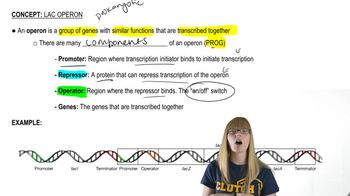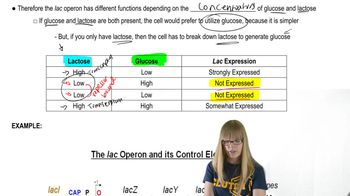Table of contents
- 1. Introduction to Genetics51m
- 2. Mendel's Laws of Inheritance3h 37m
- 3. Extensions to Mendelian Inheritance2h 41m
- 4. Genetic Mapping and Linkage2h 28m
- 5. Genetics of Bacteria and Viruses1h 21m
- 6. Chromosomal Variation1h 48m
- 7. DNA and Chromosome Structure56m
- 8. DNA Replication1h 10m
- 9. Mitosis and Meiosis1h 34m
- 10. Transcription1h 0m
- 11. Translation58m
- 12. Gene Regulation in Prokaryotes1h 19m
- 13. Gene Regulation in Eukaryotes44m
- 14. Genetic Control of Development44m
- 15. Genomes and Genomics1h 50m
- 16. Transposable Elements47m
- 17. Mutation, Repair, and Recombination1h 6m
- 18. Molecular Genetic Tools19m
- 19. Cancer Genetics29m
- 20. Quantitative Genetics1h 26m
- 21. Population Genetics50m
- 22. Evolutionary Genetics29m
12. Gene Regulation in Prokaryotes
Lac Operon
Problem 10a
Textbook Question
How would a cap⁻ mutation that produces an inactive CAP protein affect transcriptional control of the lac operon?
 Verified step by step guidance
Verified step by step guidance1
Understand the role of CAP (Catabolite Activator Protein) in the lac operon: CAP, when bound to cAMP, enhances the transcription of the lac operon by facilitating the binding of RNA polymerase to the promoter.
Recognize that a cap⁻ mutation results in an inactive CAP protein, which cannot bind to cAMP and therefore cannot assist in the transcriptional activation of the lac operon.
Consider the conditions under which the lac operon is normally activated: In the presence of lactose and absence of glucose, cAMP levels are high, allowing CAP to bind to the promoter and enhance transcription.
Analyze the impact of the cap⁻ mutation: Without active CAP, even in the presence of lactose and absence of glucose, the lac operon will have reduced transcription because RNA polymerase binding is less efficient.
Conclude that the cap⁻ mutation leads to decreased expression of the lac operon genes, as the positive regulation by CAP is impaired, affecting the cell's ability to metabolize lactose efficiently.
Recommended similar problem, with video answer:
 Verified Solution
Verified SolutionThis video solution was recommended by our tutors as helpful for the problem above
Video duration:
4mPlay a video:
Was this helpful?
Key Concepts
Here are the essential concepts you must grasp in order to answer the question correctly.
CAP Protein Function
The CAP (catabolite activator protein) is a transcription factor that enhances the expression of certain genes, including the lac operon, in response to low glucose levels. When glucose is scarce, CAP binds to cyclic AMP (cAMP), forming a complex that promotes RNA polymerase binding to the promoter of the lac operon, facilitating transcription.
Recommended video:
Guided course

Proteins
Lac Operon Regulation
The lac operon is a set of genes in E. coli that are involved in the metabolism of lactose. Its expression is regulated by the presence of lactose and glucose. In the absence of glucose, the CAP-cAMP complex binds to the lac promoter, enhancing transcription, while the presence of glucose inhibits this process, demonstrating a classic example of catabolite repression.
Recommended video:
Guided course

Lac Operon Regulation
Mutation Effects on Gene Expression
A mutation that leads to an inactive CAP protein would disrupt the normal regulatory mechanism of the lac operon. Without functional CAP, the operon would be less efficiently activated in low glucose conditions, resulting in reduced transcription of the genes necessary for lactose metabolism, even when lactose is present.
Recommended video:
Guided course

Maternal Effect

 4:27m
4:27mWatch next
Master Lac Operon Overview with a bite sized video explanation from Kylia Goodner
Start learning


